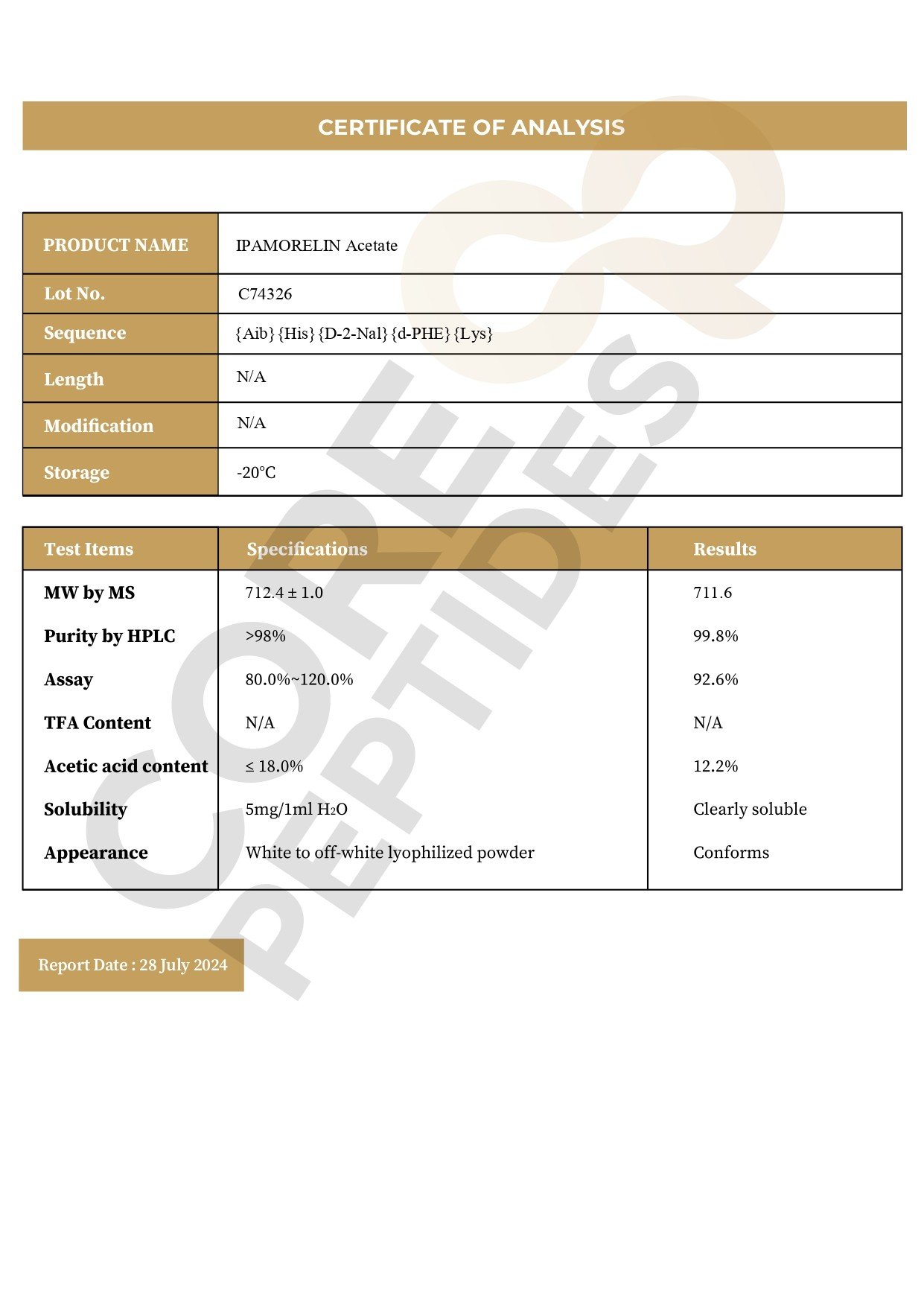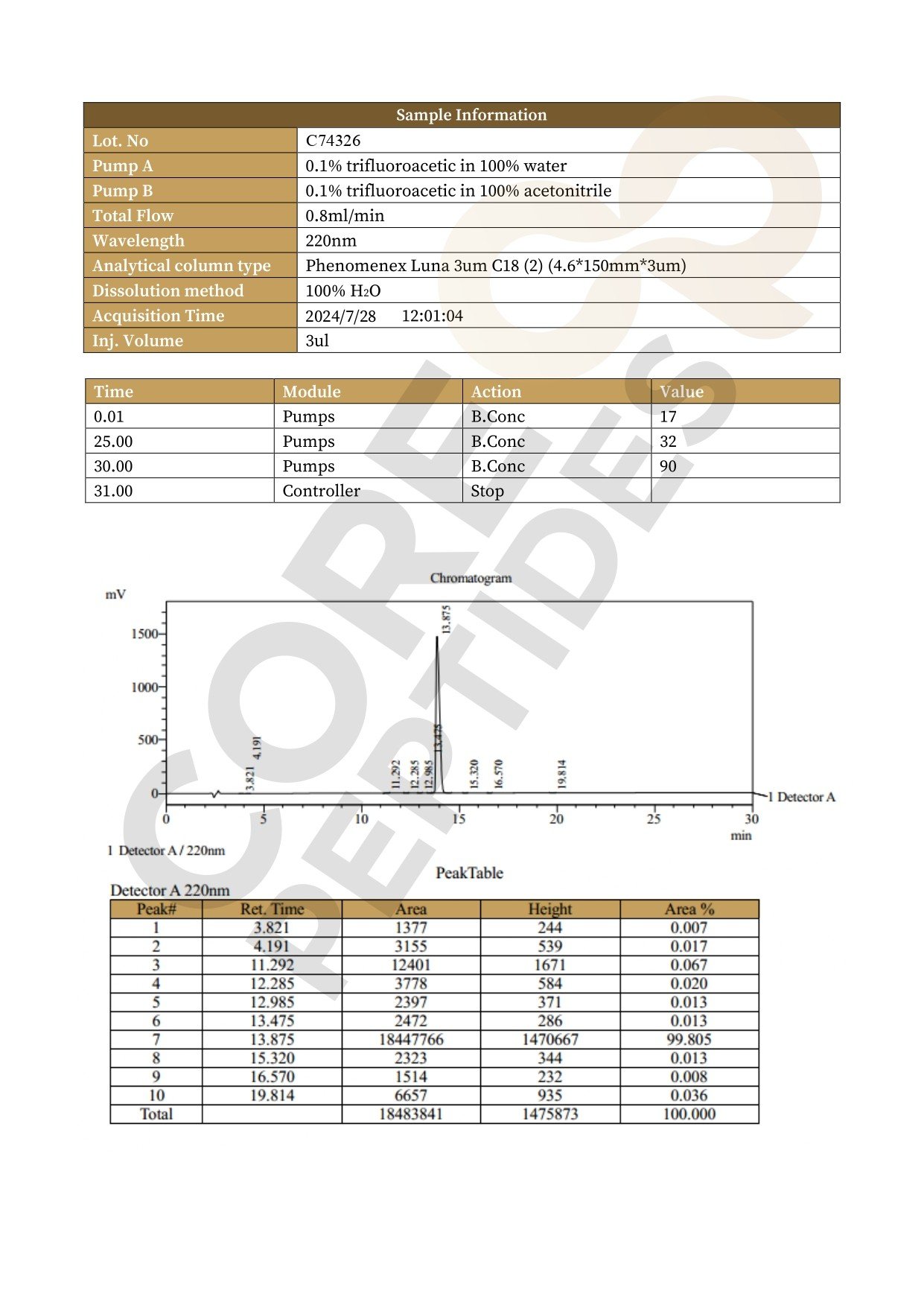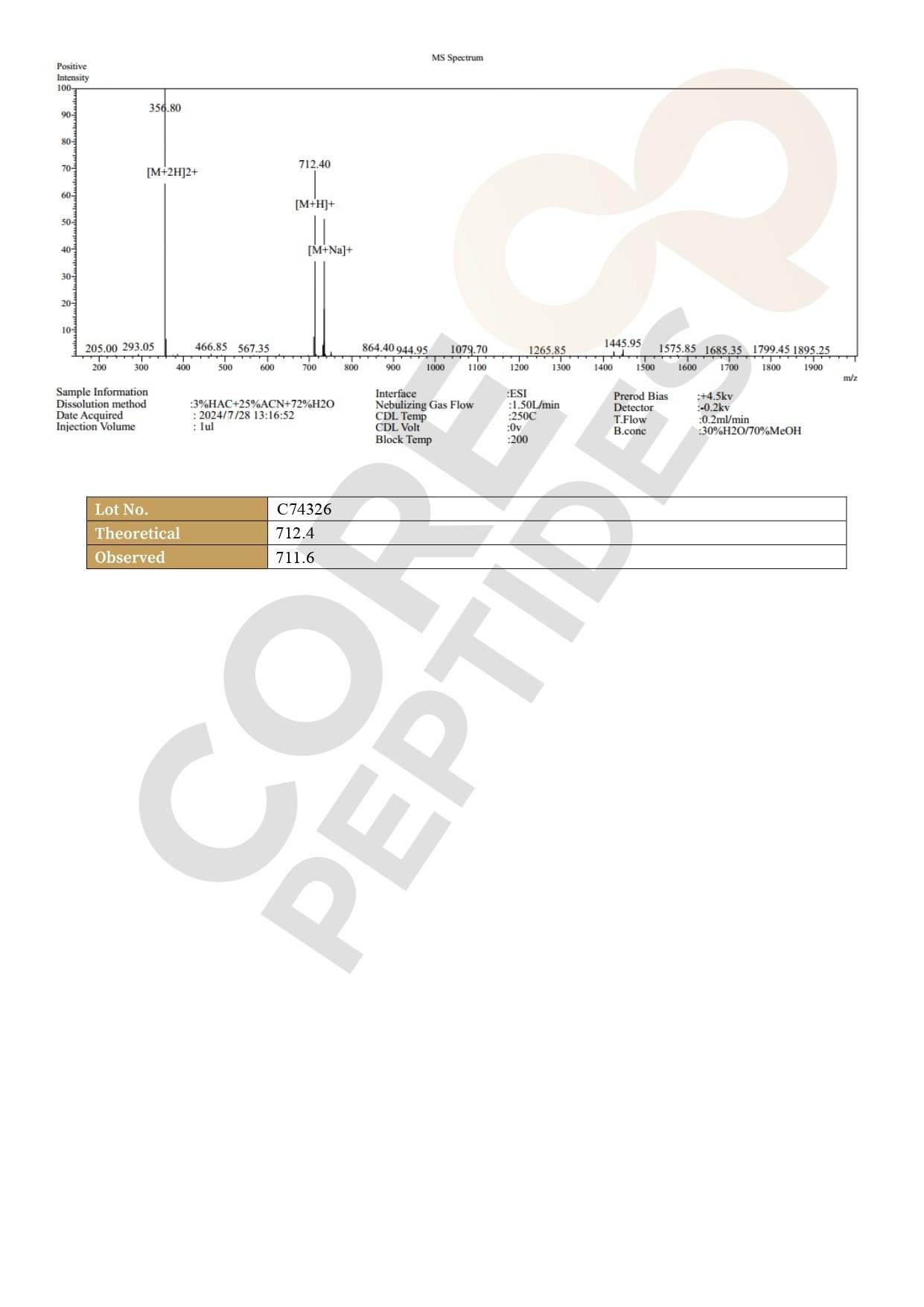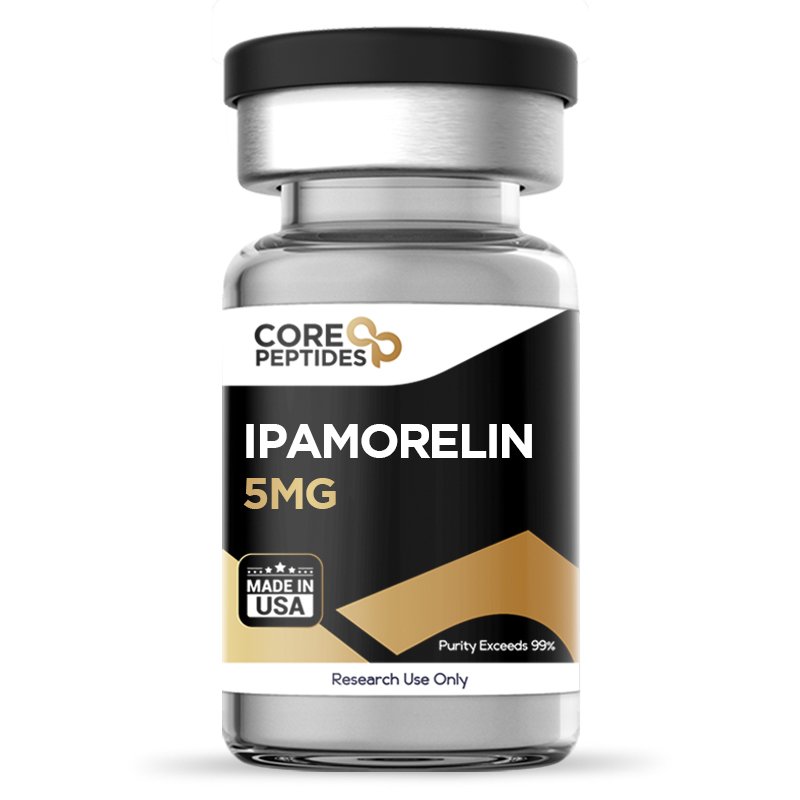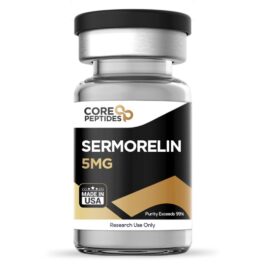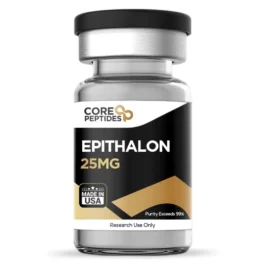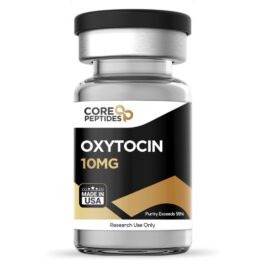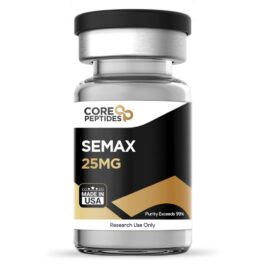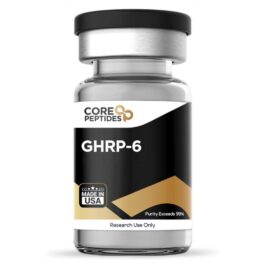Ipamorelin (5mg)
Original price was: $46.00.$43.00Current price is: $43.00.
Size: 5mg
Contents: Ipamorelin (5mg)
Form: Lyophilized powder
Purity: >99%
SKU: P-IPAMORELIN-5
FREE Shipping on $200+ orders
Discount per Quantity
| Quantity | Discount | Price |
|---|---|---|
| 5 - 8 | 5% | $40.85 |
| 9 + | 10% | $38.70 |
Ipamorelin Peptide
Ipamorelin is a synthetic peptide that is composed of five amino acids, otherwise known as a pentadecapeptide (Aib-His-D-2-Nal-D-Phe-Lys-NH2), formally classified as a Growth Hormone Secretagogue (GHS). Its name is derived from the intention of its development. Ipamorelin peptide was designed to act via ghrelin receptor binding. The ghrelin receptors on the pituitary gland (the gland naturally involved with growth hormone, or hGH synthesis) are also known as Growth Hormone Secretagogue receptors (GHS-R). Through its implied action, Ipamorelin may host the potential to trigger the GHS-Rs on the pituitary gland and potentially stimulate the release of growth hormone.(1)
Overview
Ipamorelin is the first synthetic GHS that appears highly selective and may have the potential to augment the production of hGH without affecting other pituitary hormones such as prolactin or adrenocorticotropic hormone (ACTH). The potential increase in hGH might promote lipolysis and insulin-like growth factor-1 (IGF-1) production synthesis. Consequently, IGF-1 may become a mediator of hGH’s anabolic actions, and thereby the peptide may act to increase cellular proliferation and bone and muscle anabolism.(1)
Chemical Makeup
Molecular Formula: C38H49N9O5
Molecular Weight: 711.86 g/mol
Other Known Titles: NNC 26-0161
Research and Clinical Studies
Ipamorelin Peptide and Selective Agonism
Based on one 1998 murine model-based research study, researchers suggested that Ipamorelin may release growth hormones from the pituitary cells. When Ipamorelin was presented to swine and pentobarbitone anesthetized rats, it reportedly exhibited release in growth hormones. Upon further observation, the researchers hypothesized that similar to other growth hormone (GH) stimulating peptides, Ipamorelin may be a growth receptor agonist stimulating GH release through potential affinity in growth hormone receptors. Moreover, the researchers commented that Ipamorelin appears to be the first GHS-R “agonist with a selectivity for GH release similar to that displayed by GHRH. The specificity of Ipamorelin makes this compound a very interesting candidate for future clinical development.”(1) Scientific research studies have also suggested that Ipamorelin may lead to increased hGH secretion, possibly without significantly affecting other pituitary hormones such as the levels of prolactin or ACTH.(2)
Ipamorelin Peptide and Growth Hormone Synthesis
Studies conducted in vitro suggest that the interaction of Ipamorelin with GHS receptors may potentially affect somatotroph cells in the anterior pituitary gland by triggering a series of cellular signaling events.(3) This theorized pathway involves the activation of phospholipase C (PLC), which some researchers believe may lead to the increased release of inositol triphosphate (IP3) and diacylglycerol (DAG). This release of secondary messenger molecules such as IP3 might potentially stimulate the discharge of calcium ions (Ca2+) from the cell's internal stores, while DAG might activate protein kinase C (PKC). The subsequent rise in intracellular calcium levels and the possible activation of PKC are thought to result in the exocytosis of vesicles filled with growth hormones from these pituitary cells.(3)
In late 1999, a clinical trial was carried out on eight test subjects where Ipamorelin was presented every 15 minutes for a set period. Two hours post-study, it was suggested by the researchers that the levels of growth hormone had apparently increased. More specifically, Ipamorelin appeared to have tended to boost growth hormone levels, potentially soaring to as much as 80mIU/l (roughly equivalent to a concentration of about 26.6ng/ml). When this increase is measured as a percentage compared to a placebo (with a baseline of 1.31mIU/l or 0.4ng/ml), the enhancement appeared to have exceeded a 60-fold uplift.(4)
Ipamorelin Peptide and Bone Tissue
It is conceivable that Ipamorelin may positively influence bone mineral density. The theory posits that Ipamorelin might stimulate osteoblasts (cells responsible for bone formation) via hGH-mediated mechanisms, potentially leading to their enhanced proliferation, growth, and specialization. In a particular study, murine models were exposed to either Ipamorelin or a placebo.(5) The impact of Ipamorelin on bone mineral density in these mice was monitored closely through real-time dual X-ray absorptiometry (DEXA) assessments at critical sites, including the femur and L6 vertebra. Post-experiment, the femur bones were further examined using mid-diaphyseal peripheral quantitative computed tomography (pQCT) scans. Preliminary findings implied that the peptide may have contributed to increased body mass and a probable elevation in the overall tibial and vertebral BMC (bone mineral content) as detected by DEXA compared to the placebo group. Further, the pQCT data appeared to suggest that the observed augmentation in cortical BMC may have stemmed from an enlargement in the cross-sectional area of the bone. In contrast, the cortical volumetric bone mineral density (BMD, which denotes the ratio of BMC to area) appeared to remain steady. Thus, there may have been an enlargement in the volumes of the femur and the L6 vertebrae since BMC appeared to increase while the volumetric BMDs appeared unchanged.(5)
Ipamorelin Peptide and Digestion
Researchers have delved into the potential of Ipamorelin in the functionality of the stomach, with a keen interest in its ability to possibly expedite the process of gastric emptying. For example, one study employed a technique to ascertain gastric emptying rates, which entailed monitoring the proportion of a marked substance that lingered in the stomach 15 minutes after its introduction through intragastric gavage.(6) The scientists conducted surgeries to purposefully decelerate the gastric emptying process in murine models. This deceleration was particularly noticeable in the control group. In contrast, Ipamorelin appeared to have markedly accelerated the emptying process compared to the control. This observation led the team to hypothesize that Ipamorelin might be able to increase the velocity of gastric emptying. Additional research was initiated to delve deeper into the action of the compound on the contractile potential of the stomach's smooth muscles, which were activated by acetylcholine and electrical field stimulation. Indeed, the decelerated peristalsis appeared to be mitigated when Ipamorelin and ghrelin were studied together, suggesting the idea that Ipamorelin may enhance the contractility of gastric smooth muscles.(6)
Ipamorelin Peptide and Appetite
The potential actions of Ipamorelin on ghrelin receptors may lead to an enhancement in hunger signals and, perhaps, an ensuing augmentation in body mass. Research suggests that research models exposed to Ipamorelin were observed to sustain an estimated 15% surge in body weight.(7) Researchers speculate that this substance might have led to a proportional increase in the weight of fat pads in comparison to the total body weight. Consequently, DEXA scans might indicate a comparative rise in body fat percentage. Moreover, there is speculation among researchers that Ipamorelin might elevate serum leptin levels, a hormone considered to play a crucial role in energy balance and hunger regulation. This observation has prompted scientists to consider increased food consumption as a potential contributor to the weight gain noted in research models exposed to Ipamorelin. They have posited that "GHSs increase body fat by GH-independent mechanisms that may include increased feeding.”(7)
Ipamorelin Peptide and Nitrogen Balance
Researchers have suggested that Ipamorelin may potentially mediate anabolic action, which may be due to its potential in hGH and IGF-1 synthesis and may be assessed through its impact on nitrogen balance. In a distinct investigation, researchers aimed to explore the action of Ipamorelin on specific liver markers associated with alpha-amino-nitrogen conversion during induced catabolic states.(8) The study focused on the liver’s capacity to synthesize urea-N (CUNS), which may serve as an indicator of the organ's ability to process nitrogen. The levels of messenger RNA (mRNA) related to liver urea cycle enzymes were scrutinized, alongside an assessment of the overall nitrogen balance and a hypothesis regarding nitrogen distribution across various organs. The findings suggested that Ipamorelin might have contributed to a possible 20% reduction in CUNS compared to the artificially induced catabolic condition. Furthermore, it might have diminished the expression of urea cycle enzymes, possibly restored nitrogen balance, and, in theory, altered or improved nitrogen concentrations in different organs.(8)
Ipamorelin peptide is available for research and laboratory purposes only. Please review and adhere to our Terms and Conditions before ordering.
References:
- K. Raun et al., Ipamorelin, the first selective growth hormone secretagogue, Endocrinology, November 1998.
- Sinha DK, Balasubramanian A, Tatem AJ, Rivera-Mirabal J, Yu J, Kovac J, Pastuszak AW, Lipshultz LI. Beyond the androgen receptor: the role of growth hormone secretagogues in the modern management of body composition in hypogonadal males. Transl Androl Urol. 2020 Mar;9(Suppl 2):S149-S159. doi: 10.21037/tau.2019.11.30. PMID: 32257855; PMCID: PMC7108996 https://www.ncbi.nlm.nih.gov/pmc/articles/PMC7108996/
- Jiménez-Reina, L., Cañete, R., de la Torre, M. J., & Bernal, G. (2002). Influence of chronic treatment with the growth hormone secretagogue Ipamorelin, in young female rats: somatotroph response in vitro. Histology and histopathology, 17(3), 707–714. https://doi.org/10.14670/HH-17.707
- Gobburu, J.V.S., Agersø, H., Jusko, W.J. et al. Pharmacokinetic-Pharmacodynamic Modeling of Ipamorelin, a Growth Hormone Releasing Peptide, in Human Volunteers. Pharm Res 16, 1412–1416 (1999).
- Svensson, J., Lall, S., Dickson, S. L., Bengtsson, B. A., Rømer, J., Ahnfelt-Rønne, I., Ohlsson, C., & Jansson, J. O. (2000). The GH secretagogues ipamorelin and GH-releasing peptide-6 increase bone mineral content in adult female rats. The Journal of endocrinology, 165(3), 569–577. https://doi.org/10.1677/joe.0.1650569
- Greenwood-Van Meerveld, B., Tyler, K., Mohammadi, E., & Pietra, C. (2012). Efficacy of ipamorelin, a ghrelin mimetic, on gastric dysmotility in a rodent model of postoperative ileus. Journal of experimental pharmacology, 4, 149–155. https://doi.org/10.2147/JEP.S35396
- Lall, S., Tung, L. Y., Ohlsson, C., Jansson, J. O., & Dickson, S. L. (2001). Growth hormone (GH)-independent stimulation of adiposity by GH secretagogues. Biochemical and biophysical research communications, 280(1), 132–138. https://doi.org/10.1006/bbrc.2000.4065
- Aagaard, N. K., Grøfte, T., Greisen, J., Malmlöf, K., Johansen, P. B., Grønbaek, H., Ørskov, H., Tygstrup, N., & Vilstrup, H. (2009). Growth hormone and growth hormone secretagogue effects on nitrogen balance and urea synthesis in steroid treated rats. Growth hormone & IGF research: official journal of the Growth Hormone Research Society and the International IGF Research Society, 19(5), 426–431. https://doi.org/10.1016/j.ghir.2009.01.001
